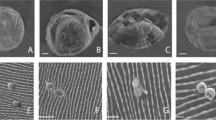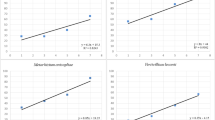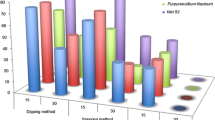Abstract
The tomato red spider mite, Tetranychus evansi Baker and Pritchard, is an invasive species in Africa causing considerable damage to Solanaceous crops. The fungal pathogen Neozygites floridana Weiser and Muma from Brazil has been considered a potential candidate for introduction into Africa for the control of T. evansi. To be incorporated in the tomato production system, N. floridana has to be compatible with the pesticides used for the control of other pests and diseases. Pesticides used in tomatoes that might affect the fungus were therefore studied by the use of different methods. Two insecticides (Lambda-cyhalothrin and Methomyl), two acaricides (Propargite and Abamectin), and two fungicides (Captan and Mancozeb) were tested in two concentrations: the mean commercial rate (CR) and 50% of the mean commercial rate (CR/2). Fungus-killed mite cadavers or the substrates used for sporulation (leaf discs and coverslips) were either immersed or sprayed with the pesticides before testing their effects on sporulation, germination of primary conidia and infectivity of N. floridana. Direct immersion of cadavers, coverslips or leaf discs into pesticides affected sporulation and germination stronger than the spray tower method, although infectivity of capilliconidia was neither affected by the method of application nor the concentration of the pesticides. The fungicides Captan and Mancozeb resulted in a high reduction in sporulation and germination at both concentrations. Propargite did not inhibit sporulation but affected germination of primary conidia. Methomyl and Abamectin resulted in less effects on N. floridana.
Similar content being viewed by others
References
Alves SB, Moino A Jr, Almeida JEM (1998) Produtos fitossanitários e entomopatógenos. In: Alves SB (ed) Controle microbiano de insetos. FEALQ, Piracicaba, Brazil, pp 217–238
Blair BW (1989) Laboratory screening of acaricides against Tetranychus evansi Baker and Pritchard. Crop Prot 8:212–216. doi:10.1016/0261-2194(89)90029-X
Bower KN, Berkett LP, Costante JF (1995) Non-target effect of a fungicide spray program on phytophagous and predacious mite populations in a scab-resistant apple orchard. Environ Entomol 24:423–430
Boykin LS, Campbell WV, Beute MK (1984) Effect of pesticides on Neozygites floridana (Entomophthorales: Entomophthoraceae) and arthropod predators attacking the two-spotted spider mite (Acari: Tetranychidae) in North Carolina peanut fields. J Econ Entomol 77:969–975
Brandenburg RL, Kennedy GG (1983) Interactive effects of selected pesticides on the two-spotted spider mite and its fungal pathogen Neozygites floridana. Entomol Exp Appl 34:240–244. doi:10.1007/BF00186919
Carner GR, Canerday TD (1970) Entomophthora sp. as a factor in the regulation of the two-spotted spider mite in cotton. J Econ Entomol 63:638–640
Delalibera I Jr, Demétrio CGB, Manly BFJ, Hajek AE (2006) Effect of relative humidity and origin of isolates of Neozygites tanajoae (Zygomycetes: Entomophthorales) on production of conidia from cassava green mite, Mononychellus tanajoa (Acari: Tetranychidae) cadavers. Biol Control 39:489–496. doi:10.1016/j.biocontrol.2006.08.003
Hall IM, Dunn PH (1959) The effect of certain insecticides and fungicides on the fungi pathogenic to alfalfa aphid. J Econ Entomol 52:28–29
Humber RA, Moraes GJ, dos Santos JM (1981) Natural infection of Tetranychus evansi (Acarina: Tetranychidae) by a Triplosporium spp. (Zygomycetes: Entomophthorales) in Northeastern Brazil. Entomophaga 26:421–425. doi:10.1007/BF02374716
Jaros-Su J, Groden E, Zhang J (1999) Effects of selected fungicides and the timing of fungicide application on Beauveria bassiana-induced mortality of the Colorado potato beetle (Coleoptera: Chrysomelidae). Biol Control 15:259–269. doi:10.1006/bcon.1999.0724
Jaques RP, Patterson NA (1962) Control of the apple sucker, Psylla mali Schmidb, by the fungus Entomopthora sphaerosprema (Fresenius). Can Entomol 94:818–825
Klingen I, Westrum K (2007) The effect of pesticides used in strawberries on the phytophagous mite Tetranychus urticae (Acari: Tetranychidae) and its fungal natural enemy Neozygites floridana (Zygomycetes: Entomophthorales). Biol Control 43:222–230. doi:10.1016/j.biocontrol.2007.07.013
Morjan WE, Pedigo LP, Lewis LC (2002) Fungicidal effects of Glyphosate and Glyphosate formulations on four species of entomopathogenic fungi. Environ Entomol 31:1206–1212
Oduor GI, Yaninek JS, van der Geest LPS, de Moraes GJ (1996) Germination and viability of capilliconidia of Neozygites floridana (Zygomycetes: Entomophthorales) under constant temperature, humidity, and light conditions. J Invertebr Pathol 67:267–278. doi:10.1006/jipa.1996.0042
SAS Institute (1998) User’s manual, version 7.0. SAS Institute, Cary, NC, USA
Saunyama IGM, Knapp M (2003) The effects of pruning and trellising of tomatoes (Lycopericon esculentum Mill.) on red spider mite (Tetranychus evansi Baker and Pritchard) incidence and crop yield in Zimbabwe. Afr Crop Sci J 11:269–277
Smith JW, Furr RE (1975) Spider mites and some natural control agents found in cotton in the delta area of Mississippi. Environ Entomol 4:559–560
Smitley DR, Brooks WM, Kennedy GG (1986) Environmental effects on production of primary and secondary conidia, infection and pathogenesis of Neozygites floridana, a pathogen of two-spotted spider mite, Tetranychus urticae. J Invertebr Pathol 47:325–332. doi:10.1016/0022-2011(86)90103-5
Wells ML, McPherson RM, Ruberson JR, Herzog GA (2000) Effect of fungicide application on activity of Neozygites fresenii (Entomophthorales: Neozygitacea) and cotton aphid (Homoptera: Aphididae) suppression. J Econ Entomol 93:1118–1126
Yendol WG (1968) Factors affecting germination of Entomophthora conidia. J Invertebr Pathol 10:116–121. doi:10.1016/0022-2011(68)90271-1
Acknowledgements
We thank Prof. Dr. Gilberto Jóse de Moraes and the two anonymous reviewers for their valuable comments on the ealier version of this manuscript, Prof. Dr. Celso Omoto for permission to use the spray tower and his laboratory to perform part of the experiments, Ana Elizabete Lopes Ribeiro and Nádia Fernanda Bertin Casarin for their kind assistance in performing the bioassays. The first author is a recipient of a fellowship from the Academy of Sciences for the Developing World (TWAS) and the Brazilian National Council for Scientific and Technological Development (CNPq). The study was partly funded by the German Federal Ministry for Economic Cooperation and Development (BMZ).
Author information
Authors and Affiliations
Corresponding author
Rights and permissions
About this article
Cite this article
Wekesa, V.W., Knapp, M. & Delalibera, I. Side-effects of pesticides on the life cycle of the mite pathogenic fungus Neozygites floridana . Exp Appl Acarol 46, 287–297 (2008). https://doi.org/10.1007/s10493-008-9168-4
Received:
Accepted:
Published:
Issue Date:
DOI: https://doi.org/10.1007/s10493-008-9168-4




